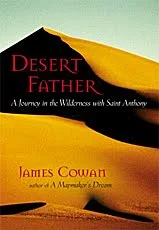The day was spent in a flurry of preparation. Many last minute things had to be addressed: liturgy, music, reception food, and so forth. I was busy finishing my latest icon project, a large image of our patron, St. Anthony which needed to be dry in time to be blessed during the earlier Eucharist. The day came on the heels of a busy weekend and the opening of the Easter term. But the air was filled with excitement rather than anxiety and worry, for this day was to be the beginning of a new chapter in my life and I had set aside ample time beforehand to prayerfully reflect on the sacramental profession of monastic vows.
Once everything was in place, people arriving in the night's crisp air, it was truly going to happen. The organ burst forth and began the hymn, my abbot leaned towards me with, "are you ready?" There was no turning back now.
I had thought long before that the "moment" for me would come when I was to be prostrate on the seminary chapel's cold stone floor--lying vulnerable at the foot the cross. The music that I chose for this moment was something very dear to me, the Taize chant, "Jesus, Remember Me." A favorite of mine, I had incorporated it into the healing services that I led at St. Matthew's Homeless Shelter just two short years ago. That place was a deep mark in my heart and an important time for my formation. There I came face-to-face with the wounded Christ in so many people hungry for wholeness. I can still recall their faces, the smell of the annointing oil, and the repetitious chorus of the chant. All of those memories flashed before me as I laid on the floor with tears.

But to my surprise, that was not the moment. It came when my abbot placed the black habit of our Order over me. Trying to find my way through the dark, hooded garment was the moment--I distinctly recall a feeling of being lost and alone. I remember saying to myself, "this isn't supposed to be the moment!" But alas, it was. Inside the clothing was my journey, my journey from death to life, from darkness to light. It all happened in the space of a minute or so, but inside it felt as though time stood still. It all became clear when I peaked my head through the hood, it was true.
Ending one chapter and beginning a new one was the deep emotional stuff inside of me that day. I never thought that by entering seminary I would stumble upon the catalyst to discern a contemplative call that has really been there in my soul for a long, long time. It went unanswered for too long, and for too long it struggled to find its authentic voice inside of me. That changed and so did I.
I can truly say that professing vows is indeed a sacrament. Grace came when I unexpected it, inside the darkness of a habit. That moment will forever stay with me, most likely because I was not ready for it. God does indeed have a sense of humor. I wish I could sometimes understand it. Perhaps in silence, perhaps one day. I stand ready to begin this new chapter and to see what new unexpected graces will happen. Silentio Coram Deo.













